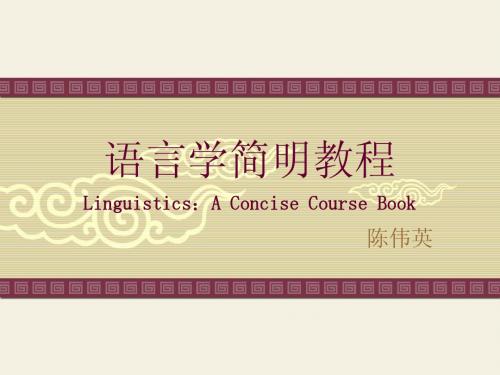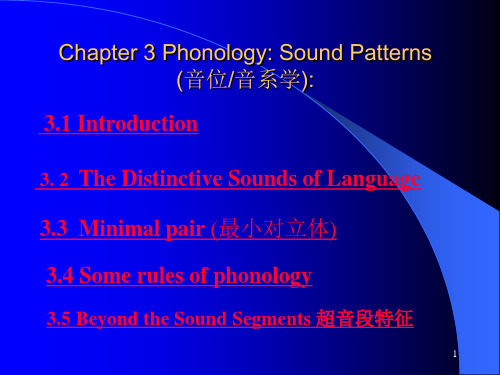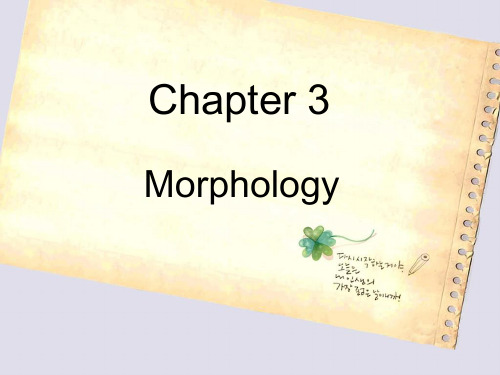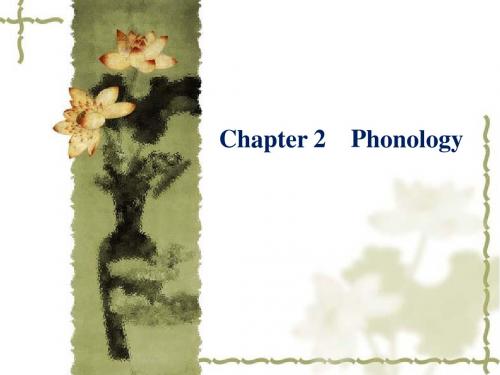《简明语言学教程》课件 第1、2、3章
《语言简明》PPT课件

第二节
整体感知
新课导入 整体感知 深入探究 课堂小结 拓展延伸 板书设计 布置作业
整体感知—— 学习目标
1.掌握“语言简明”的基本要求。 2.掌握使“语言简明”的方法。 3.掌握考查语言表达简明连贯得体的试题的题型及解题思路。
新课导入 整体感知 深入探究 课堂小结 拓展延伸 板书设计 布置作业
它的插图都是立体的。当你把书打开的时候,书里的人和 动物会马上站起来,“跃然纸上”,栩栩如生。
读一读,说说你觉得这段文字 它在语言表达上有什么问题吗?
新课导入 整体感知 深入探究 课堂小结 拓展延伸 板书设计 布置作业
整体感知---典例分析
这段文字的语言不够简明。“立体的”出现两次,字面重复;“吸 引人”和很多人围上去看,意思重复;“当你把书打开的时候”,不够简 洁。因此,可以改成下面这样:
人类在人类社会这个体系中,也在不断地竞争着:有的为那些名利在竞争, 有的为真理事业去竞争。
[参考答案]自然界中,万物都在竞争:为食物竞争,为生存空间竞争。当 然,人类社会中,竞争也不断:有的为名利竞争,有的为真理事业竞争。
新课导入 整体感知 深入探究 课堂小结 拓展延伸 板书设计 布置作业
深入探究——注意事项
词语的重复有时是相同词语的重复。例如: ①他说他在阵地上掩埋烈士的时候,他掉了眼泪。 ②你们好心肠要好到底,我们上礼拜的一块钱总得补给我们。 例①中三个“他”指代对象相同,语法作用也相同,可以删掉最后一个 “他”;例②中两个“我们”表达重复,删除前一个“我们”会更简明。
新课导入 整体感知 深入探究 课堂小结 拓展延伸 板书设计 布置作业
新课导入 整体感知 深入探究 课堂小结 拓展延伸 板书设计 布置作业
深入探究——注意事项
语言学简明教程

• 重要名词概念
语言 说话 交际工具 思维 社会 社会现象
第一单元 语言的社会功能
• 学习目标
弄清楚语言和说话的关系 认识语言是一种特殊的社会现象 领会语言是人类最重要的交际工具 认识语言是人类思维的工具 弄清楚语言和思维的关系 理解语言具有民族性,而思维能力是全人类共同的
第二单元 语言是符号系统
• 学习目标
认识社会发展促进语言发展;了解语言要素的相互 制约的关系对语言发展的影响;认识语言发展的特点。 了解语言分化的原因;认识社会方言及其形成原因; 认识地域方言及其划分;了解语言的谱系分类。 认识语言是随着社会的统一而统一的理论;认识共 同语及其在现代社会生活中的重要性;了解共同语的规 范和汉语规范化问题。
第七单元 语言随着社会的发展而发展
• 学习内容提要
语言是不断地发展变化地,社会发展是语言发展 的根本原因, 语言中各个要素相互制约,其中某种要 素的变化也会影响语言的变化;语言的发展变化具有 渐进性和不平衡性的特点;语言随着社会发展而分化、 统一,亲属语言、方言、共同语的形成与社会的发展 密切相关。
第四单元 语法
• 学习内容提要
讲授语法结构的基本规律,包括构成语法的单位--句子、词组、词、语 素,以及语素和词组合成更大语法单位的类型,语法结构的层次性与递归性特点, 语法的聚合规则,句子的变换、语言结构的类型和普遍特征。
• 教学目的要求
认识语法的结构单位,掌握语法的组合规则和聚合规则的基本精神;能运 用已学的语法理论分析和阐释常见的语法现象,如语法结构的层次关系、语法意 义与语法形式、语法手段与语法范畴、句子的多义与同义、句式的变换等;认识 不同语言语法结构的特点。
• 学习内容提要
教授语音的物理属性、胜利属性,语音单位的分 类及发音原理,音位的划分原理,音位的组合和音节, 以及记录语音的符号--国际音标。
《戴炜栋 新编简明英语语言学教程 第2版 笔记和课后习题 含》读书笔记PPT模板思维导图下载

4.3 考研真题与 典型题详解
第5章 语义学
5.2 课后习题详 解
5.1 复习笔记
5.3 考研真题与 典型题详解
第6章 语用学
6.2 课后习题详 解
6.1 复习笔记
6.3 考研真题与 典型题详解
第7章 语言变化
7.2 课后习题详 解
7.1 复习笔记
7.3 考研真题与 典型题详解
第8章 语言与社会
《 戴 炜 栋 新 编 简 明 最新版读书笔记,下载可以直接修改 英语语言学教程
第2版 笔记和课后 习题 含》
思维导图PPT模板
01 第1章 导 言
目录
02 第2章 音位学
03 第3章 形态学
04 第4章 句法学
05 第5章 语义学
06 第6章 语用学
目录ቤተ መጻሕፍቲ ባይዱ
07 第7章 语言变化
08 第8章 语言与社会
8.2 课后习题详 解
8.1 复习笔记
8.3 考研真题与 典型题详解
第9章 语言与文化
9.2 课后习题详 解
9.1 复习笔记
9.3 考研真题与 典型题详解
第10章 语言习得
10.2 课后习题 详解
10.1 复习笔记
10.3 考研真题 与典型题详解
第11章 第二语言习得
11.2 课后习题 详解
11.1 复习笔记
11.3 考研真题 与典型题详解
第12章 语言与大脑
12.2 课后习题 详解
12.1 复习笔记
12.3 考研真题 与典型题详解
读书笔记
谢谢观看
第1章 导 言
1.2 课后习题详 解
1.1 复习笔记
1.3 考研真题与 典型题详解
语言学简明教程Chapter 2

12
What’s the properties of every speech sound? What state is the speech organ when a particular sound is produced? How many organs are concerned? How do speech sounds differ from each other? Properties of Consonants 1. The state of the vocal cords (voicing: voiced/voiceless): voiced: [b] [d] [g] [v] [z] [ ] [ ] [ ] etc. voiceless: [p] [t] [k] [f] [s] [ ] [ ] [ ] etc. They are the only voiceless consonants in English (8), and vowels are all voiced. 2. The position of the velum (nasality: nasal/oral) In English, the three sounds [ ], [n], and [ ] are nasal. All the other sounds are oral.
②
③
④
approximants: [
], [w], [l], [r], [h].
The Description of English consonants
①
stops/plosives: [p], [b], [t], [d], [k], [g]; fricatives: [ ], [v], [s], [z], [ ], [ ], [ ], [ Forcing aair through a narrow passage,ofbut and ②. slowly ]; narrow passage. A combination ① release through
语言学简明教程Chapter 3

1
3.1 Introduction
Phonology is the study of the sound patterns(systems) of language. It is concerned with the linguistic patterning of speech sounds, that is, the ways in which speech sounds form systems and patterns in human languages, with its primary aim being to discover the principles that govern the way sounds are organized in languages, and to explain the variations that occur. It is also called phonemics.
Chapter 3 Phonology: Sound Patterns (音位/音系学): 3.1 Introduction
3. 2 The Distinctive Sounds of Language
3.3 Minimal pair (最小对立体) 3.4 Some rules of phonology
For example, the words “pan” and “ban” differ only in the initial sound: „pan‟ beg with /b/. Therefore, /p/and /b/ are phonemes in English. The number of phonemes varies from one language to another. English 6 is often considered to have 44 phonemes.
新编简明英语语言学教学课件中文版

第一章:绪论1.什么是语言学?1.1定义语言学常被定义为是对语言进行系统科学研究的学科。
语言学研究的不是某一种特定的语言,而是人类所有的语言。
为了揭示语言的本质,语言学家首先要对语言实际使用进行观察,并在此基础上形成有关语言使用的概括性假设,这些初步形成的假设要在语言使用中进行进一步的检验,最终形成一条语言理论。
1.2语言学的研究范畴:语言学研究有不同的侧重。
对语言体系作全面研究的语言学研究称为普通语言学。
语音学主要是对语言声音媒介的研究,它不只是研究某一特定的语言的声音媒介,而是所有语言的声音媒介。
音系学与语音学不同,它主要研究特定语言的语音体系,即音是如何结合在一起产生有意义的单位。
形态学主要研究单词的内部语义结构,及这些叫做词素的语义最小单位是如何结合构成单词。
句法学主要研究构成潜在句子的句法规则。
语义学以研究语义为目的,传统语义学主要研究抽象的意义,独立于语境之外的意义,语用学也是研究语义,但是它把语义研究置于语言使用语境中加以研究。
语言不是一个孤立的现象,而是一种社会现象,各种社会因素都会对语言的使用产生影响。
从社会的角度来研究语言的科学被称之为社会语言学。
语言和社会之间的关系是社会语言学研究的主要内容。
心理语言学主要从心理学的角度来研究语言。
它要研究人们在使用语言时大脑的工作机理,如人是如何习得母语的,人的大脑是如何加工和记忆语言信息等问题。
把语言学的研究成果应用到实践中的科学形成了应用语言学。
狭义上,应用语言学指把语言理论和原则运用于语言教学的科学,在广义上,它指把语言理论与原则应用于解决实际问题的科学。
除此之外还有人类语言学、神经语言学、数学语言学、计算语言学等。
1.3语言学研究中的几对基本概念1.3.1规定性和描述性语言学研究是描述性的,不是规定性的。
这是语言学和传统语法的一个重要区别。
语言学研究的目的是对人们使用的语言进行客观描述与分析,而不是对语言的使用作出规定。
传统语法是规定性的,它主要建立在笔头语言基础之上,旨在规定一系列的语法规则,并且把这些语法规则强加给语言使用者。
《新编简明英语语言学教程》PPT课件

Chomsky’s definition (1957)
“From now on I will consider language to be a
set of (finite or infinite) sentenБайду номын сангаасes, each finite in length and constructed out of a finite set of elements.”
• • • • •
Arbitrariness Productivity/Creativity Duality Displacement Cultural transmission
Arbitrariness
----No logical (motivated or intrinsic) connection between sounds and meanings. Onomatopoeic words (which imitate natural sounds) are somewhat motivated ( English: rumble, crackle, bang, …. Chinese: putong, shasha, dingdang… ) Some compound words are not entirely arbitrary, e.g. type-writer, shoe-maker, air-conditioner, photocopy…
Language is arbitrary
Arbitrary---- no intrinsic connection between the word and the thing it denotes, e.g. “pen” by any other name is the thing we use to write with.
简明英语语言学教程

Chapter one Introduction一、定义1. Linguistics 语言学Linguistics is generally defined as the scientific study of language.2. General Linguistics 普通语言学The study of language as a whole is often called General linguistics.3. Language 语言Language is a system of arbitrary vocal symbols used for human communication. 语言是人类用来交际的任意性的有声符号体系。
4. Design Features 识别特征It refers to the defining properties of human language that distinguish it from any animal system of communication.语言识别特征是指人类语言区别与其他任何动物的交际体系的限定性特征。
⑴Arbitrariness任意性There is no logical connection between meanings and sounds.P.S the arbitrary nature of language is a sign of sophistication and it makes it possible for language to have an unlimited source of expressions⑵Productivity多产性Animals are quite limited in the messages they are able to send.⑶Duality双重性Language is a system, which consists of two sets of structures, or two levels.⑷Displacement移位性Language can be used to refer to contexts removed from the immediate situations of the speaker.⑸Cultural transmission文化传递Human capacity for language has a genetic basis, but we have to be taught and learned the details of any language system. This showed that language is culturally transmitted. Not by instinct. Animals are born with the capacity to produce the set of calls peculiar to their species.5. Competence 语言能力Competence is the ideal user’s knowledge of the rules of his language.6. Performance 语言运用Performance is the actual realization of this knowledge in linguistic communication. 语言运用是所掌握的规则在语言交际中的体现。
戴炜栋《简明英语语言学教程》Chapter_3_Morphology320

3.2 Morphemes 1. word: a minimal free form of a language that has a given sound and meaning and syntactic function.
3.2 Morphemes Discussion: Try to study the internal structures of the following words to find out the smaller meaningful components. internationalization blackboard worked tourists
2) Bound morphemes Free root: (free morpheme) a root which has a clear and definite meaning and which can be used as a word; All the root words are free roots.
3.1 Introduction Morphology: a branch of grammar which studies the internal structure of words and the rules by which words are formed. predict: pre: before dict: speak Can pre- and dict be structurally and semantically further analyzed?
Alter the meaning or derivational affixes: grammatical category of the base
简明语言学教程

戴版语言学Chapter One - I ntroductionPart one -- W hat is linguistics?1. Definition -- l inguistics is generally defined as the scientific study of language.Scientific means it is based on the systematic investigation of linguistic data, conducted with reference tosome general theory of language structure.No Article before language in this definition means that linguistics studies language in general.Linguists ' task: basically study and understand the general principles upon which all languages are built.I nterest of linguists is “what is said ”2. The scopes of linguisticsGeneral linguistics --- t he study of language as a whole ---- the core of linguisticsPhonetics -- the study of sounds used in linguistic communication.Phonology ---- t he study of how sounds are put together and used to convey meanings incommunication.Morphology --- t he study of the way in which the symbols are arranged and combined to formwords.Syntax ---- t he study of the rules for sentence formationSemantics ----- t he study of meaning.Pragmatics ---- t he study of meaning in the context of language use.Above are made up of the core of linguisticsSociolinguistics ---- t he study of all social aspects of language and its relation with society fromthe core of the branch.Psycholinguistics ----- t he study of language processing, comprehending and production, as well aslanguage acquisition.Applied linguistics ---- t he application of linguistic theories and principles to language teaching ,especially the teaching of foreign and second languages.3. Some important distinctions in linguistics.(1) prescriptive vs. descriptiveprescriptive the linguistic study aims to lay down rules for “ correct and standardbehavio using language, i.e. to tell people what they should say and what they should not say.Descriptive ---- t he linguistic study aims to describe and analyze the language people actually use.Modern linguistics is mostly descriptive.(2) Synchronic vs. diachronicSynchronic ---- t he description of a language at some point of time in history.Diachronic ---- t he description of a language as it changes through time ------------------ the historicaldevelopment of language over a period of time --- another name: historical linguistics.A synchronic approach enjoys priority over a diachronic one.(3) Speech vs. writingTwo major media of linguistic communicationSpeech is prior to writing:(1) writing system is always “ invented ” by its users to recordspeech.(2) speech plays a greater role than writing in information conveyance.(3) speech is acquired as mother tongue while writing is learned and taught.(4) speech reveals true features of human speech while writing language is only the “ revised ” record of speech.(4) Langue vs. paroleProposed by Swiss linguist -- F. de Saussure --- sociological view.Purpose: discover the regularities governing the actual use of language and make them the subjects of study of linguistics. Langue ---- t he abstract linguistic system shared by all the members of s speechcommunity. --- abstract & stable.Parole ----- t he realization of language in actual use -- concrete & varied(5) Competence vs. performanceProposed by American linguist Noam Chomsky --- p sychological viewPurpose: discover and specify the internalized sets of rules.Competence the ideal user 's knowledge of the ruleslaonf ghuisage.Performance - the actual realization of this knowledge in linguistic communication.(6) Traditional grammar and modern linguisticsThe beginning of modern linguistics-- the publication of Saussure '“s Coursein General Linguistics ” in early 20th Modern linguistics differs traditional grammar:(1) descriptive vs. prescriptive.(2) spoken language vs. written language.(3) ML doesn 't force languages into a La-tbinased framework.Part Two --- What is language?1. Definition - language is a system of arbitrary vocal symbols used for human communication.System ---- e lements of language are combined according to rules.Arbitrary --- there is no intrinsic connection between a linguistic symbol and what symbol standsfor.Vocal --- the primary medium for all language is sound.Human ---- l anguage is human-specific.2. Design features - p roposed by American linguist Charles Hockett.(5/12)Design features: the defining properties of human language that distinguish it from any animal system of communication-------------------------------------- human-specific.(1) Arbitrariness - there is no logical connection between meanings and sounds.Exceptions: Onomatopoeic words and some compound words are not entire arbitrary.(2) Productivity --- language is creative in that it makes possible the construction and interpretationof new signals by its users ------ users can produce and understand sentences that they have neverheard before.(3) Duality ---- (another name: double articulation.) Language is a system which consists of twosets of structures, or two levels. The lower lever is the structure of meaningless sounds and the higher level is the structure of meaning. --------------------------------------- sound & meaning(4) Displacement --- l anguage can be used to refer to things which are present or not present, realor imagined matters in the past, present, or future, in a faraway places ----- It doesn 't matter howfar away the topic is of conversation is in time or space ------------- f ree from the barriers caused by separation in time and place.(5) Cultural transmission -- the capacity for language is genetically based while the details of andlanguage system should be taught and learned. ---- language is passed down from one generationto the next through teaching and learning, rather than by instinct.3. The functions of language.(1) Informative: The main function of language that when people use language to communicatewith each other, their experience in the real world, record or describe the “ content ” of they are actually taking advantage of this function. ---------------------------------- the most important function.(2) Interpersonal: people establish and maintain their identity in the society by this function.(3) Performative: this is a function whereby the language influences directly on the reality, such as the sentence of imprisonment by the judge, the naming of a certain ship and the curses as believed by the ancient people.(4) Emotive: this function is performed by those linguistic elements used to express strong feelings, such as exclamatory expressions.(5) Phatic: this is function realized by those “ Phaticlanguage ”a,iming to establishing aharm onious and in timate relati on ship among people. Examples in Chin ese :吃了没?in En glish: Good norning. & A nice day, isn 't it?(6) Recreational: This function means that sometimes people may enjoy language for languagesake, i.e. no using language in any practical purposes, such as tongue-twisters and children 's babbles and chanter 's chanting.(7) Metalingual: people may use language to talk about, explain or even change language itself. This is the metalingual function of language. For example, we may use “ book ”to refer to theexisting object in the real world, and yet may also use “the word book ” to stand by the conce “book” as embodied in language.Chapter 2: PhonologyPart One: The phonic Medium of LanguageLinguists concern only with the sounds that are produced by humans through their speech organs and have a role to play in linguistic communication.phonic medium : The meaningful speech sound in human communication.Speech sounds: the individual sounds within phonic medium are the speech sounds.Part Two: Phonetics1. What is phonetics?phonetics : The study of phonic medium of language and it is concerned with all sounds in the world 's languages. Classification:articulatory phonetics : It studies sounds from the speaker 's point of view, i.e. how a speaker uses his speech organs to articulate the sounds. ---------------------------------- s peakerauditory phonetics: The studies sounds from the hearer 's point of view, i.e. how the sounds are perceived by the hearer. --- heareracoustic phonetics: It studies the way sounds travel by looking at the sound waves, the physical means by which sounds are transmitted through the air from one person to another. ------------------------------------ physicalproperties2. Organs of Speech1 the pharyngeal cavity -- t hroat.2 the oral cavity------------ m outh. ---- tongue: most flexible.3 the nasal cavity ---------- nose. In English, there are three nasal sounds, namely, [m], [n], [ n ] voicing: the way that sounds are produced with the vibration of the vocal cords.voiceless: the way that sounds are produced with no vibration of the vocal cords.3. Orthographic representation of speech sounds -- broad and narrow transcriptions.IPA: short for International Phonetic Alphabets, a system of symbols consists of letters anddiacritics, used to represent the pronunciation of words in any language.broad transcription: The use of letter symbols only to show the sounds or sounds sequences in written form.narrow transcription: The use of letter symbol, together with the diacritics to show sounds in written form.diacritics: The symbols used in the narrow transcription to show detailed articulatory features of sounds.aspiration: A little puff of air that sometimes follows a speech sound.4. Classification of English Speech SoundsClassification:consonant: a speech sound in which the air stream is obstructed in one way or another.vowel : a speech sound in which the air stream from the lung meets with no obstruction.1 Classification of English consonants:1 Manner of articulation: The manner in which obstruction is created.Stops: [p], [b], [t], [d], [k], [g].Fricatives: [f], [v], [s], [z], [ ], [ / ] [3], [h]],[Affricates: [t / ],[d3]Liquids: [l], [r].Nasals: [m], [n], [ n]Glides: [w], [j]. ----- semi-vowels2 place of articulation : The place where obstruction is created.Bilabial: [p], [b], [m], [w].Labiodental: [f], [v]Den tal: [ 0]],[Alveolar: [t], [d], [s], [z], [n], [l], [r]Palatal: [ / ] [3], [t / ],[d3], [j].Velar: [k], [g], [ n]Glottal: [h].Manner of articulation, place of articulation and voicing/ voiceless help describe a consonant.2 Classification of English V owels.1 the position of the tongue:front: [i:], [i], [e], [ s ], [?], [a]central: [ 3 :], \] 3 ], [/back: [u:], [u], [o], [o:], [a:]2 the openness of the mouth.Close vowels: [i:], [i], [u:], [u],Semi-close: [e], [ 3 :]Semi-open: [ 3 ], [o:]Open vowels: [?], [a], [/\],[o], [a:]3 shape of the lips:unrounded: [i:], [i], [e], [ s ], [?],同呼] 3 :], [ 3 ], [/rounded: [u:], [u], [o], [o:].4 length of the sound:long vowels: [i:], [ 3 :], [u:], [o:], [a:]short vowels: [i], [e], [ s ], [?\]],,[ua], [o]. 3 ], [/5 monophthong : the individual vowel. --- above vowels are all monophthongs.diphthong : The vowel which consists of two individual vowels, and functions as a single one. [ei], [ai], [oi], [i 3 ], [au],[ eig3htud],ip[ehtho3ng]s,.[u 3]Part Three: Phonology1. Phonology and Phoneticsphonetics : The study of phonic medium of language and it is concerned with all sounds in the world ' s languages. phonology : The description of sound systems of particular languages and how sounds function to distinguish meaning. Similarity: all concerned with the same aspect of language --- t he speech sounds.Differences: approach and focus.1 Phonetics is of a general nature; it is interested in all the speech sounds used in all humanlanguages ---- how they are produced, how they differ from each other, what phonetic features theypossess, how they can be classified.2 Phonology aims to discover how speech sounds in a language from patterns and how these sounds are used to convey meaning in linguistic communication.E.g. allophones clear [l] and dark [l]:Phonetically speaking, they are interested in the differences how they are pronounced. Phonologically speaking, they are the same in functioning conveyance of the meanings.2. Phone, Phoneme, and Allophonephone : The speech sound we use when speaking a language, which does not necessarily distinguish meaning in the English language.phoneme : The smallest unit of sound in a language which can distinguish two sounds.allophone : any different forms of the same phoneme in different phonetic environments, e.g. clear[l] and dark [l] of the same [l], aspirated [p] and unaspirated [p] of the same [p] in different phonetic environments.3. Phonemic contrast, complementary distribution, and minimal pairphonemic contrast : two similar sounds occur in the same environment and distinguish meaning.E.g. [b] in [bit] and [p] in [pit] form phonemic contrast. complementary distribution : allophones of t he same phoneme and they don 't distinguish meaning but complement each other in distribution. E.g. clear [l] and dark [l] respectively in the pronunciation of light and feel.minimal pair: two different forms are identical in every way except one sound and occurs in the same position. The two sounds are said to form a minimal pair. E.g. bat and bet are a minimal pair.4. Some Rules in Phonology1 sequential rules: The rules to govern the combination of sounds in a particular language.2 assimilation rule: The rule assimilates one sound to another by copying a feature of a sequential phoneme, thus making the two phones similar.3 deletion rule: The rule that a sound is to be deleted although it is orthographically represented.5. Suprasegmental Features -- stress, tone, intonationsuprasegmental features: The phonemic features that occur above the level of the segments syllable, word, sentence are called suprasegmental features, which include stress, toneand intonation.1 Stress:Classification: word stress & sentence stress.Word Stress:1 The location of stress in English distinguishes meaning.A shift of stress may change the part of speech of a word from a noun to a verb although its spelling remains unchanged.E.g. ‘ imimp'ottp(no)rt (v), ‘nre)-c--o-r-dre( ' cord (v)‘ blackbird (compound-) -‘ black ‘ bird (noncompound)2 The meaning-distinctive role played by word stress is also manifested in the combinations of-ing forms and nouns. E.g. ' dining room(compound)---sleeping ' baby (noncompound)Sentence Stress:Sentence stress: It refers to the relative force given to the components of a sentence.he parts of speech that are normally stressed in an English sentence are: N, V, Adj., Adv., Numerals, demonstrative pronouns. E.g. He is driving my car. -------------------------------------- He drive, my, car.2 Tone:tone: Tones are pitch variations, which are caused by the differing rates of vibration of the vocal cords.Tone (pitch variation) can distinguish meaning in such languages as Chinese, but English is not a tone language.3 Intonation:intonation: When pitch, stress and sound length are tied to the sentence rather than the word in isolation, they are collectively known as intonation.Intonation plays a very important role in the conveyance of meaning in almost every language, especially in a language like English. -------------------------------------- f our basic types of intonation, namely, the falling tone,the rising tone, the fall-rise tone, the rise-fall tone.The falling tone ----- w hat is said is a straight forward, matter-of-fact statement.The rising tone ------ m ake a question of what is said.The fall-rise tone --- i ndicate that there is an implied message in what is said.Chapter 3: MorphologyPart One: Morphology1. Open class and closed classopen class: A group of words, which contains an unlimited number of items, and new words canbe added to it. --- content words. E.g. beatnik: a member of the Beat generation, or a person whorejects or avoids conventional behaviour.closed class: A relatively few words, including conjunctions, prepositions and pronouns, and new words are not usually added to them. ---------------------------------- function words.2. Internal structure if words and rules for word formationmorphology: A branch of linguistics that studies the internal structure of words and rules for word formation.Part Two: Morphemes --- t he minimal units of meaningmorpheme: The smallest unit of meaning of a language. It can not be divided without altering or destroying its meaning. bound morpheme: Morpheme that can not be used alone, and it must be combined wit others. E.g. ■ment.free morpheme: a morpheme that can stand alone as a word.affix: a letter or a group of letter, which is added to a word, and which changes the meaning or function of the word, including prefix, infix and suffix.suffix: The affix, which is added to the end of a word, and which usually changes the part of speech of a word.prefix: The affix, which is added to the beginning of a word, and which usually changes the meaning of a word to its opposite.Part three: Derivational and inflectional morphemes derivational morpheme: Bound morpheme, which can be added to a stem to form a new word. inflectional morpheme: A kind of morpheme, which are used to make grammatical categories, such as nu mber, tense and case. E.g.-ed and -ng endings are in fleet ional morphemes.inflection: the morphological process which adjusts words by grammatical modification, e.g. in The rains came, rain is inflected for plurality and came for past tense.Part Four: Morphological rules of word formationmorphological rules: The ways words are formed. These rules determine how morphemes combine to form words.Part Five Compoundscompound words: A combination of two or more words, which functions as a single words the noteworthy:1 When two words are in the same grammatical category, the compound will be in this category: E.g. post box, landlady (n+n=n), blue-black, icy-cold (adj.+adj.=adj.)2 In many cases, the two words fall into different categories, then the class of second or final word will be the grammatical category if the compound.E.g. under ‘take (v), in 'action (n), up 'lift (v)3 It is often the case that compounds have different stress patterns from the noncompounded word sequence.E.g. ‘redcoat, ‘greenhouse are compounds, but red coat and green house are not.4 The meaning of a compound is not always the sum of the meanings of its parts.E.g. bigwig, highbrow, jack-in-a-box, turncoatConclusion: Morphological rules reveal the relations between words and provide the means for forming new words. It is these rules that enable us to coin new words. Compounding is a very common and frequent process for enlarging the vocabulary of the English language.Chapter 4: SyntaxPart One: What is Syntax?syntax: A branch of linguistics that studies how words are combined to form sentences and the rules that govern the formation of sentences.Part Two: Categories1. Word-level categoriescategory: It refers to a group of linguistic items which fulfill the same or similar functions in a particular language such as a sentence, a noun phrase or a verb.syntactic categories: Words can be grouped together into a relatively small number of classes, called syntactic categories. Major lexical categories: (as heads) N, V , A, VWord-level categoriesMinor lexical categories: det. Deg. Qua. Aux. con.major lexical category: one type of word level categories, which often assumed to be the heads around which phrases are built, including N, V, Adj, and Prep.minor lexical category: one type of word level categories, which helps or modifies major lexical category.Three criteria to determine a word ' s category?1 Meaning:1 Word categories often bear some relationship with its meaning:■ Nouns typically denote entities such as human beings and objects.■ Verbs, characteristically designate action, sensation and sat tes.2 The meaning associated with nouns and verbs can be elaborated in various ways:■ The property or attribute of the entities denoted by nouns can be elaborated by adjectives.■ Theproperties and attributes of the actions, sensations and states designated by verbs can typically be denoted by adverbs.3 It is misleading to assume that a word ' s category can be told straightforward from its meaning.■ Nouns such as dilemma and friendship do not concretely reveal their entities.■ Some words such as love and hate which indicate actions tend to be verbs but they can also be used as nouns.■ Words with the same or similar meanings sometimes belong to different word categories, such as be aware of and know about.2 Inflection:1 Words of different categories take different inflections. Words of different categories take different inflection.■Nouns such as boy and desk take the plural affix s. -■Verbs such as work and help take ed and -ng.-■Adjectives such as quiet and clever take er and -est. -2 Although i nflection is very helpful in determining a word 's category, it does not always suffice.■Nouns like moisture, fog, do not take plural form s. -■Adjectives like frequent and intelligent do not take er or -est. -3 Distribution: Distribution is what type of elements can co-occur with a certain word.■ Nouns can typically appear with a determiner like the girl and a card.■ Verbs with an auxiliary such as should stay and will go.■ Adjectives with a degree word such as very cool and too bright.Conclusion: Th us, a word ' s distributional facts together with information about its meaning and inflectional capabilities help identify is syntactic category.2. Phrase categories and their structuresphrase: syntactic units that are built around a certain word category are called phrase, the category of which is determined by the word category around which the phrase is built.phrase category: the phrase that is formed by combining with words of different categories. In English syntactic analysis, four phrasal categories are commonly recognized and discussed, namely, NP, VP, PP, AP.Whether formed of one or more than one word, phrases consist of two levels, phrase level and word level.NP VP AP PP < --------- phrase levelN V A P < -------- word levelPhrase that are formed of more than one word usually contain head, specifier and complement. head: The word round which phrase is formed is termed head.specifier: The words on the left side of the heads are said to function as specifiers. complement: The words on the right side of the heads are complements. Part Three Phrase Structure Rulephrase structure rule: The special type of grammatical mechanism that regulates the arrangement of elements that make up a phrase is called a phrase structure rule.NP----- > (Det) N (PP) …. AP---- > (Deg) A (PP)….VP ---- > (Qual) v (NP) …. PP——> (Deg) P (NP)1. XP RuleIn NP, AP, VP, PP phrases, the specifier is attached at the top level to the left of head while complement is attached to the right. These similarities can be summarized with the help of the template , in which X stands for the head N, V,A,P.: TheXP rule: XP ---------------------------------------------------------------------------------------------- > (specifier) X(complement)XP rule: In all phrases, the specifier is attached at the top level to the left of the head while the complement is attached to the right. These similarities can be summarized as an XP rule, in which X stands for the head N,V,A or P.2. X —TheoryX —theory: A theoretical concept in transformational grammar which restricts the form of context-free phrases structure rules.The intermediate level formed by the head and the complement between word level and phrase level is represented by the symbol X —. Thus the new three-level structures can be written as follows:a. XP——> (specifier) X —b. X———> X (compleme nt)3. Coordination Rulecoordination: Some structures are formed by joining two or more elements of the same type with the help of a conjunction such as and or or. Such phenomenon is known as coordination. Such structure are called coordination structure.Four important properties:1 There is no limit on the number of coordinated categories that can appear prior to the conjunction.2 A category at any level (a head or an entire XP) can be coordinated.3 Coordinated categories must be of the same type4 The category type of the coordinate phrase is identical to the category type of the elements being conjoined. Coordination Rule: X ----- > X *Con XPart Four: Phrase elements1. Specifiersspecifier: The words on the left side of the heads and which are attached to the top level, are specifiers.Specifiers have both special semantic and syntactic roles:■ Semantically, they help make more precise the meaning of the head.■ Syntactically, they typically make a phrase boundary.The syntactic category of the specifier differs depending on the category of the head.2. Complements complement: The words on the right side of the heads are complements. Complements are themselves phrases and provide information about entities and locations whose existence is implied by the meaning of the head. They are attached to the right of the head in English.subcategorization: the information about a word complement 'is s included in the head and termed suncategorization.XP > (Specifier) X (Complements*)“ * ” means the fact that complements, however many there are, occur to the right of the head in English.Miss Hebert believes that she will win.“that -” ------ complementizer: Words which introduce the sentence complement are termedcomplementizer.“she will win c”omplement clause: The sentence introduced by the complementizer.“ thatshe will win ” -------- complement phrase: the elements, including a complementizer and acomplement clause.“ MissHebert believes -”--- matrix clause: the contrusction in which the complement phrase is embedded.3. modifiersmodifier: the element, which specifies optionally expressible properties of heads is called modifier.XP > (Spec) (Mod) X (Complement*) (Mod)This rule allows a modifier to occur either before the head or after it. Where there is a complement, amodifier that accurs after the head will normally occur to the right of the complement as well. Part Five : Sentences (The S Rule)1 The S rule : S -- > NP VP (This analysis is based on the assumptionn that unlike other phrases,which contains a head, a complement and a pecifier, S does not have an internal structure.)2 Another view : Many linguists beliebve that sentences, like other phrases, also have their own heads. They take abstract category inflection as their heads, which indicates the sentence and agreement, Like other phrases, Infl takes an NP as its specifier and a VP as its complement.1 Infl realized by a tense label ---- The boy found the book.2 Infl position realized by an auxiliary -- A boy will find the book.Part Six : Transformations1. Auxiliary movement transformation : a special type of rule that can move an element from one position to another. The yes-no question structures are built in two steps :1 The usual XP rule is used to form a structure in which the auxiliary occupies its normal position in Infl, between subject and the VP.2 In forming a yes-no question requires a transformation known as inversion to move the auxiliary from the Infl position to a position to the left of the subject, C position.inversion : the process of transformation that moves the auxiliary from the Infl position to a position to the left of the subject, is called inversion.Such type of inversion operation involving the movement of a word from the head position in one phrase into the head position in another is known as head movement.2. Do Insertion How to form a yes-no question that does not conta in an overt Infl such as “ Birds fly. ” Linguists circumvents this problem by adding the special auxiliary verb do. So we can formulate an insertion rule:Do insertion: Insert interrogative do into an empty Infl position.Do insertion : In the process of forming yes-no question that does not contain an overt Infl, interrogative do is inserted into an empty Infl positon to make transformation work.3. Deep structure and surface structure deep structure : A level of abstract syntactic representation formed by the XP rule. surface structure : A level of syntactic representation after applying the necessary syntactic movement, i.e., transformation, to the deep structure.The XP rule---> Deep structure ---> Transformation ---> Surface structure. (Subcategorization restricts choice of complements.)4. Wh Movement Wh question : In English, the kind of questions beginning with a wh- word are called wh question. Wh movement :The transformation that will move wh phrase from its position in deep structure to a position at the beginning of the sentence. This transformation is called wh movement.【Practice】Draw a tree diagram of the sentence: She has finally found the man who she loves.5. Move a and constraints on transformationsmove a : a general rule for all the movement rules, where ‘ alpha ‘ is a cover term foe any elemeithat can be moved from one place to another.Constraints: 1 Inversion can move an auxiliary from the Infl to the nearest C position, but not to a more didtant C position.E.g.: Deep structure: Mike should know that the train might be late. T: Should Mike know whether the train might be late?(V)F: Might Mike should know whether the train be late? (存2 No element may be removed from a coordinate structure. E.g.: Deep structure: The little girl will tell us a story and a joke. F: What will the little girl tell us a story or? (存。
(精选)《简明语言学教程》_第1、2、3章

Questions from students
5
Understand Macroscopically
To get the macrostructure of the section, we have to:
– 知识超链接:逻辑划分 – Read 1.2.1.1-1.2.1.7, find out their relations and think about the criteria
Reasoning
推理功能
is down
Communicating 交际功能
With
language
Pleasure 愉悦功能
Conclusions 1. Not an exhaustive list of functions 2. 子项排斥, 但 a specific use of language may fulfill more than one function 3. 标准:语言在我们的社会生活中能干什么?
• Understand Microscopically
(自学内容)
2
Question Time!
3
Puzzling Question!
Amazing Question!
All Questions Are Welcome
Interesting Question!
Serious question!
即“语言之于社会生活”
9
Metafunction? 元功能?纯理功 能?莫名其妙
看看其理论来源 吧!理论有点复 杂,不过其基本 概念是常要考察
的呦!
10
纯理功能(元功能)的概念是M. A. K Halliday的“系统功能语法”(SystemicFunctional Grammar) 的重要概念之一。 想知道Halliday 的功能思想是怎么来读, 这可是个很理论的问题,感兴趣的同学
新编简明英语语言学教程 教案PPT 第一章上

semantics(语义学)--the study of the meaning of language pragmatics(语用学)-- the study of meaning in the context of
language use.
The scopes of linguistics
sociolinguistics(社会语言学)-- how social factors affect language use psycholinguistics(心理语言学)-- linguistics behavior and
morphology(形态学)--the study of the way in which morphemes are arranged and combined to form words (the form of words)
syntax(句法学 )--the study of the rules that govern the combination of words to form grammatically permissible sentence
简明语言学教程

1.2 What is language?什么是语言
[A] The definition of language = SHAV Language is a system of arbitraryvocal symbols used for human communication. (语言是一个具有任意性、用于人类交流的语音符号系统。) a) System: combined together according to rules(根据规则组合在一起) b) Arbitrary: no intrinsic connection between a linguistic symbol and what the symbol stands for (语言符号和符号所代表的事物之间没有内在的必然的联系) (所有语言的首要媒介都是声音) c) Vocal: the primary medium for all languagesis sound. d) Human: language is human-specific(语言是人类所独有的) [B]Design features (unique properties): the defining properties of human language that distinguish it from any animal system of communication(识别特征是指人类语言区别于任何动物交际系统的本质特征)
简明语言学教程第2章Chapter 2-Phonology

[j]: the narrowing of space between the hard palate and the front of
the tongue [t] [d]: the obstruction created between the tip of the tongue and the velar ridge [θ] [ð ]: partial obstruction between the upper front teeth and the tip of
Classification of vowels
1. According to the position of the tongue in the mouth: front/central/back vowels front vowel: the front part of tongue maintains the highest
semi-open vowels: [ə] [ɔ:]
The place of articulation
1. Bilabial; 2. Labiodental; 3. Dental or interdental; 4. Alveolar; 5. Palato alveolar; 6. Palatal; 7. Velar; 8. Uvular; 9. Glottal.
[t] [d]
[f]
[v]
[k] [g]
Fricatives
Affricates
VL
VD VL VD
[θ]
[ ð]
[s]
[z]
([tʃ] ) ([dʒ])
[ʃ]
[ʒ] [ tʃ ] [ dʒ ]
[h]
Nasals
《语言简明》课件(共38张PPT)

写作指导
教师导语
删繁就简三秋树, 领异标新二月花。
——郑板桥
本课目标
1.了解语言简明的基本要求,明白语言简明的重要性。 2.总结阅读和写作的经验,知晓写作简明清晰地表情达 意的方法,删去繁言,斟酌用词,增强语言表达的能力。 3.培养认真修改文章、使文章更加简明的好习惯,养成 热爱祖国语言文字的好品性,热爱科学,富于想象。
利润一定很高,看来买化妆品能挣不少钱呢!最后,我
只好失落地走出了商店。
这段文字主要写“我”去商店里给妈妈买眼霜,表现“我”对 妈妈的感恩之情。文中划线部分偏离中心,分散了叙事主题, 使语段表意不明了,应把它删去。
人教部编版语文七年级下册第六单元 写作 《语言简明》课件(共38张PPT)
人教部编版语文七年级下册第六单元 写作 《语言简明》课件(共38张PPT)
⑤我冒了严寒,回到相隔二千余里,别了二十余
年的故乡去。
——鲁迅《故乡》
⑥充满整个夏天是一种紧张、热烈、急促的旋
律。
——梁衡《夏》
Байду номын сангаас
⑦我的母亲虽然很高大,然而很瘦,自然不算重;
儿子虽然很胖,毕竟幼小,自然也很轻。
—— 莫怀戚《散步》
⑧我们在田野散步,我,我的母亲,我的妻 子和儿子。
——莫怀戚《散步》 ⑨我不由得停住了脚步。
于这个题目都有很多话,下面就是我要说 的关于母爱的故事。
为写而写
案例2 变化
在初中的两年学习生活里,我们的班主任 既是严师又是慈母。她为了把我们从不懂事的 顽童,教育成有道德、有文化的一代新人,曾 不知付出了多少的心血,当我们犯了错误的时 候,她耐心细致地做思想工作,从不大吼大叫 ,当有同学生了病的时候,她就像慈母一样去 爱护、照管他。
- 1、下载文档前请自行甄别文档内容的完整性,平台不提供额外的编辑、内容补充、找答案等附加服务。
- 2、"仅部分预览"的文档,不可在线预览部分如存在完整性等问题,可反馈申请退款(可完整预览的文档不适用该条件!)。
- 3、如文档侵犯您的权益,请联系客服反馈,我们会尽快为您处理(人工客服工作时间:9:00-18:30)。
Metafunction? 元功能?纯理功 能?莫名其妙
看看其理论来源 吧!理论有点复 杂,不过其基本 概念是常要考察 的呦!
纯理功能(元功能)的概念是M. A. K Halliday的“系统功能语法”(SystemicFunctional Grammar) 的重要概念之一。 想知道Halliday 的功能思想是怎么来读, 这可是个很理论的问题,感兴趣的同学 看这里 下面我来简单介绍一下“系统功能语法”
General functions
metafunctions
• 一般功能:
– 语言之于社会生活的,即语言能干什么? 具体的功能。 •纯理功能(元功能): – 语言之于语言的,即语言本身有什么样的结构、系统、词汇语法、 语音可以帮助语言本身完成它的功能?理性的、抽象的功能 – 三个纯理功能在任意一个语言现象中是同时起作用的。 •关 系: – 语言完成的社会功能是千变万化的,具有无限的可能性,但我们可 以把它们归纳为若干个有限的抽象的功能,这就是“纯理功能”或 “元功能”这是种种语言用途所固有的(胡壮麟、朱永生、张德录, 1996:11)。 – 任何一个句子,不管它表达的是什么一般功能,都可以用三个纯理 功能来阐释。
– 知识超链接:系统功能语法
– The relation between general function and metafunction
超链接:实用逻辑教程 逻辑划分 (classification)
• 逻辑划分 • 组成部分
– 是明确概念外延的逻辑方法。从形式上讲,它是把一个属概念划分成 若干个种概念。
男 人 啊 , 你 为 什 么 伤 感 ?
外延相称吗? 子项排斥吗? 标准统一吗?
General function
Physiological
生理功能 get rid of
Phatic
nervous Record things maintaining us to identify or we wish to social the things hysical energy remember relationship
Question for you!
你知道黄健翔为 什么下课吗?
General (2):Phatic Function(寒暄功能)
Phatic function: language used for establishing an atmosphere or maintaining social contact rather than for exchanging information or ideas. Greeting, farewells, and comments on the weather serve this function. e.g. A nice day, isn’t it?
• • • • • •
1
Emotive Conative (意动的) Referential Poetic Phatic communion Metalinguistic
Jakobson from Dai’s Book
• ideational • interpersonal • Textual
2
Halliday’s classification
– 划分的母项——被划分的属概念 – 划分的子项——被划分的种概念 – 划分的标准——进行划分的依据
• 划分规则
– 外延相称(即子项外延之和等于母项的外延),否则会犯“多出子项” 或“遗漏子项”的逻辑错误。 – 子项排斥(子项的外延必须互相排斥),否则会犯“子项重叠”的错 误。 – 统一标准(如,按国际将人分成中国人、日本人、美国人等),否则 会犯“标准混乱”的错误。
参与者 环境 直陈 祈使
语式mode 典型体现: 口语、书面
共 同 决 定 要 完 成 三 种 功 能
概念功能 (内容)
语态
归一度 语气
陈述句 疑问句
人际功能 (关系)
情态
语调 主位结构
语篇功能 (方式)
信息结构
衔接
所指 替代 省略 连接 搭配
有点抽象! 举个例子吧!
Leave a kiss wir wine.
寒暄功能 Create or
Recording
Identifying
记录功能
识别功能 Lg enables
Reasoning
推理功能
is down With language
Communicating
Pleasure
交际功能
愉悦功能
Conclusions 1. Not an exhaustive list of functions 2. 子项排斥, 但 a specific use of language may fulfill more than one function 3. 标准:语言在我们的社会生活中能干什么? 即“语言之于社会生活”
系统功能语法:系统?功能?语法?社会符号? 语法= 语法词汇 语音体现 SVO SV
语义= 社会语境
决 定
功能= 意义潜势
选 系统及其子系统= 可进行语言 择 选择的网络 过程 及物系统
体 现 物质 思维 言语 ...
语场Field 语篇的社会活动 典型体现:题材 语旨 Tenor 角色关系 典型体现: 正式度
Understand Microscopically
• (2)Metafunctions of Language
– Ideational function – Interpersonal function – Textual function
Let’s study those puzzling you
Understand Microscopically
The function of Language
• (1)General functions of Language
– – – – – – – Physiological function Phatic function Recording function Identifying function Reasoning function Communicating function Pleasure function
1.2.3 The Function of Language
Teaching Objective
• Critical Thinking
– Present and Solve Problems
• Understand Macroscopically
– To understand logical classification
Understand Macroscopically
To get the macrostructure of the section, we have to:
– 知识超链接:逻辑划分
– Read 1.2.1.1-1.2.1.7, find out their relations and think about the criteria of classification.
(参与者1) 物质过程
肯定、否定
主动语态
• 归一度系统
人际功能分析
• 语气系统:
Leave a kiss within the cup
(主语)
超链接: 言语角 色与交 流物
主语(对提议的有效和成功负责的成分)和语气成分(助动词)
时间、情态(概率及意愿) 祈使语气:求取、请求
• 情态系统:
讲话者对自己讲的命题的成功性和有效性所作的判断,或在命令中要求对方 承担的义务,或在提议中要表达的个人意愿
General(1):Physiological Function(生理功能)
Language can help get rid of nervous or physical energy. It can either be (1) Emotive/expressive function: the use of language to reveal something about the feelings and attitudes of the speaker e.g. expression of fear and affection Good heavens! Damn it! More complex ones are: I’m extremely sorry about…. We’re most grateful for this. or (2) Evocative function: the use of language to create certain feelings in the hearer. Its aim is to amuse, startle, anger, soothe, worry or please.
• 概念功能分析 • 人际功能分析 • 语篇功能分析
概念功能分析
• 及物系统:过程、参与者、环境分别是什么?
Leave a kiss within the cup
(参与者1) 物质过程 参与者2 环境
• 语态系统: 过程首先和哪个参与者建立联系?
Leave a kiss within the cup
语言的功能的分类及标准
Following are different classification of the language function
• Descriptive • Expressive • Social Dai & He’s Book
• • • • • • •
Physiological function Phatic function Recording function Identifying function Reasoning function Communicating function Pleasure function Yang Xinzhang’s Book
